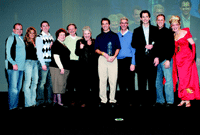
Representatives from Winchester Optical celebrate after being named Transitions Lab of the Year. Among the celebrants are, Dave Cole, general manager, Transitions (fourth from right), Brian Lynch, president of Winchester Optical (third from right) and Brian Hauser, director, lens manufacturer and trade channel sales for Transitions (second from right). |

Transitions’ director of research and development, John Ligas (l), and general manager Dave Cole announce details of the new Transitions XTRActive lens. |
ORLANDO—More than 1,400 people attended the 14th annual Transitions Academy, held here Jan. 31 to Feb. 2, to see Winchester Optical named the company’s Lab of the Year and hear Transitions executives describe the new Transitions XTRActive photochromic lens. The firm also unveiled a revamped consumer Web site and new TV commercials, plus a new marketing tool designed to encourage employers to offer vision coverage.
At Transitions Academy, Elmira, N.Y.-based Winchester was cited for boosting its sales of Transitions lenses by 20 percent in 2009. Brian Hauser, Transitions’ director, lens manufacturer and trade channel sales, said the optical lab—whose president, Brian Lynch, and his team accepted the award—“truly set the stage for excellence.”
A key element of this year’s Academy was introduction of the XTRActive lens, designed to be darker than the current Transitions VI lens in outdoor conditions, and to provide “moderate” darkness behind a car’s windshield. John Ligas, Transitions’ director of research and development, said the new lens has an 80 percent tint in sunlight, versus 73 percent for Transitions VI under the same conditions, and a 50 percent tint inside a car. The XTRActive lens retains about a 17 percent tint indoors, while the Transitions VI lens is clear indoors.
Described by Transitions general manager Dave Cole as “the darkest photochromic lens you can buy,” the XTRActive joins the ongoing Transitions VI in the company’s “everyday” lens segment, and will be sold at “a slight premium price over the Transitions VI.”
Transitions will begin delivering the lens in the U.S. and Canada in March; roll-out to the rest of the world “will be determined by its applicability in other regions,” according to Cole. A new Web site for the lens, www.TransitionsXTRActive.com, goes live in mid-February, but Cole told VM the company will be depending primarily on eyecare practitioners to help consumers decide between the new XTRActive and the Transitions VI as everyday lenses.
Recalling that Transitions introduced an earlier-generation photochromic lens called XTRActive in the mid-1990s, Cole noted, “It’s an old name, but this is a new product, and we’re very excited about it.”
To promote its growing family of lenses—which also includes performance sun lenses under the name SolFX—Transitions has two new TV commercials for 2010, one using the tag line, “Ask your eyecare professional which Transitions lenses are right for you,” the other highlighting the firm’s link with the PGA Golf Tour.
Said Greg Marko, director, North American marketing, “In the past, Transitions was one brand, one company. But through consumer research we’ve realized there is more need for adaptive technology, and more than one consumer we’re trying to reach.” Transitions wants to deliver three key messages to consumers about what its products provide: comfort, convenience and protection.
The company features its family of lens brands on a revamped Web site, www.Transitions.com, designed to help consumers understand and explore their lens choices. A new trade portal—www.Transitions.com/pro—joins the site during this year’s first half, Marko said.
In addition, Transitions will support its brand identity as well as its Healthy Sight initiative by again sponsoring the Transitions Championship for Healthy Sight PGA golf tournament, scheduled for March 15 to 21. And the company will build on the interactive billboard program it kicked off last year, Marko noted.
This year’s Transitions Academy also saw the launch of the Healthy Sight Calculator, an online tool designed to help employers see how they could reduce health-care costs by providing a managed vision plan and encouraging regular eyecare for employees.
The Healthy Sight Calculator launch was part of a managed vision track that featured a panel of human resources executives exploring their experiences with vision plans. In addition, Vincent Young, MD, chair of the division of ophthalmology at Albert Einstein Medical Center in Philadelphia, and Kovin Naidoo, OD, of South Africa’s International Center for Eye Care Education, discussed links between various diseases and eye/vision problems. ■
—Cathy Ciccolella
cciccolella@jobson.com